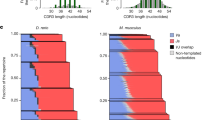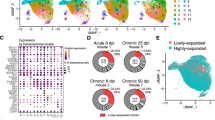Abstract
The murine Ly49 gene family encoding natural killer cell receptors for class I MHC is an example of a rapidly evolving cluster of immune response genes. Determining the genomic sequence of the 129S6/SvEvTac (129S6) Ly49 cluster and comparing it to the known sequence of the C57BL/6 (B6) region provided insight into the mechanisms of Ly49 gene evolution. 129S6 contains 20 Ly49, many of which are pseudogenes and 40% of the genes have no counterpart in the B6 genome. The difference in gene content between these two strains is primarily the result of distinct patterns of gene duplication. Phylogenetic analyses of individual exons showed that Ly49 genes form distinct sub-families and an ancestral haplotype can be surmised. Dotplot analysis supports limited allelism in the two haplotypes; however, large regions of variation punctuate these islands of co-linearity. These variable regions contain a high concentration of repetitive elements that are predicted to contribute to the dynamic evolution of this cluster. The extreme variation in Ly49 haplotype content between mouse strains provides a genetic explanation for the documented differences in natural killer cell phenotype, and also indicates that differences in natural killer cell function observed between B6 and 129-derived gene-targeted mice should be interpreted with caution.
This is a preview of subscription content, access via your institution
Access options
Subscribe to this journal
Receive 6 digital issues and online access to articles
$119.00 per year
only $19.83 per issue
Buy this article
- Purchase on Springer Link
- Instant access to full article PDF
Prices may be subject to local taxes which are calculated during checkout







Similar content being viewed by others
References
Mestas J, Hughes CC . Of mice and not men: differences between mouse and human immunology. J Immunol 2004; 172: 2731–2738.
Yuhki N, Beck T, Stephens RM, Nishigaki Y, Newmann K, O'Brien SJ . Comparative genome organization of human, murine, and feline MHC class II region. Genome Res 2003; 13: 1169–1179.
Amadou C, Kumanovics A, Jones EP, Lambracht-Washington D, Yoshino M, Lindahl KF . The mouse major histocompatibility complex: some assembly required. Immunol Rev 1999; 167: 211–221.
Gagnier L, Wilhelm BT, Mager DL . Ly49 genes in non-rodent mammals. Immunogenetics 2003; 55: 109–115.
Takahashi T, Yawata M, Raudsepp T et al. Natural killer cell receptors in the horse: evidence for the existence of multiple transcribed LY49 genes. Eur J Immunol 2004; 34: 773–784.
Mager DL, McQueen KL, Wee V, Freeman JD . Evolution of natural killer cell receptors: coexistence of functional Ly49 and KIR genes in baboons. Curr Biol 2001; 11: 626–630.
McQueen KL, Wilhelm BT, Harden KD, Mager DL . Evolution of NK receptors: a single Ly49 and multiple KIR genes in the cow. Eur J Immunol 2002; 32: 810–817.
Vilches C, Parham P . KIR: diverse, rapidly evolving receptors of innate and adaptive immunity. Annu Rev Immunol 2002; 20: 217–251.
Volz A, Wende H, Laun K, Ziegler A . Genesis of the ILT/LIR/MIR clusters within the human leukocyte receptor complex. Immunol Rev 2001; 181: 39–51.
Carrington M, Norman P . The KIR Gene Cluster. National Library of Medicine (US), NCBI: Bethesda, MD, 2003.
Wilson MJ, Torkar M, Haude A et al. Plasticity in the organization and sequences of human KIR/ILT gene families. Proc Natl Acad Sci USA 2000; 97: 4778–4783.
Kubota A, Kubota S, Lohwasser S, Mager DL, Takei F . Diversity of NK cell receptor repertoire in adult and neonatal mice. J Immunol 1999; 163: 212–216.
Karlhofer FM, Ribaudo RK, Yokoyama WM . MHC class I alloantigen specificity of Ly-49+ IL-2-activated natural killer cells. Nature 1992; 358: 66–70.
McVicar DW, Burshtyn DN . Intracellular signaling by the killer immunoglobulin-like receptors (KIR) and Ly49. Science's STKE 2001. http://stke.sciencemag.org/cgi/content/full/OC_sigtrans;2001/75/re1.
Makrigiannis AP, Pau AT, Schwartzberg PL, McVicar DW, Beck TW, Anderson SK . A BAC contig map of the Ly49 gene cluster in 129 mice reveals extensive differences in gene content relative to C57BL/6 mice. Genomics 2002; 79: 437–444.
Wilhelm BT, Gagnier L, Mager DL . Sequence analysis of the Ly49 cluster in C57BL/6 mice: a rapidly evolving multigene family in the immune system. Genomics 2002; 80: 646–661.
Proteau M-F, Rousselle E, Makrigiannis AP . Mapping of the BALB/c Ly49 cluster defines a minimal natural killer cell receptor gene repertoire. Genomics 2004; 84: 669–677.
Idris AH, Smith HR, Mason LH, Ortaldo JR, Scalzo AA, Yokoyama WM . The natural killer gene complex genetic locus Chok encodes Ly-49D, a target recognition receptor that activates natural killing. Proc Natl Acad Sci USA 1999; 96: 6330–6335.
Scalzo AA, Fitzgerald NA, Simmons A, La Vista AB, Shellam GR . Cmv-1, a genetic locus that controls murine cytomegalovirus replication in the spleen. J Exp Med 1990; 171: 1469–1483.
Scalzo AA, Fitzgerald NA, Wallace CR et al. The effect of the Cmv-1 resistance gene, which is linked to the natural killer cell gene complex, is mediated by natural killer cells. J Immunol 1992; 149: 581–589.
Burge C, Karlin S . Prediction of complete gene structures in human genomic DNA. J Mol Biol 1997; 268: 78–94.
Waterston RH, Lindblad-Toh K, Birney E et al. Initial sequencing and comparative analysis of the mouse genome. Nature 2002; 420: 520–562.
Saleh A, Makrigiannis AP, Hodge DL, Anderson SK . Identification of a novel Ly49 promoter that is active in bone marrow and fetal thymus. J Immunol 2002; 168: 5163–5169.
Wilhelm BT, McQueen KL, Freeman JD, Takei F, Mager DL . Comparative analysis of the promoter regions and transcriptional start sites of mouse Ly49 genes. Immunogenetics 2001; 53: 215–224.
Saleh A, Davies GE, Pascal V et al. Identification of probabilistic transcriptional switches in the Ly49 gene cluster: a eukaryotic mechanism for selective gene activation. Immunity 2004; 21: 55–66.
Toyama-Sorimachi N, Tsujimura Y, Maruya M et al. Ly49Q, a member of the Ly49 family that is selectively expressed on myeloid lineage cells and involved in regulation of cytoskeletal architecture. Proc Natl Acad Sci USA 2004; 101: 1016–1021.
Tanamachi DM, Moniot DC, Cado D, Liu SD, Hsia JK, Raulet DH . Genomic Ly49A transgenes: basis of variegated Ly49A gene expression and identification of a critical regulatory element. J Immunol 2004; 172: 1074–1082.
Yokoyama WM, Kehn PJ, Cohen DI, Shevach EM . Chromosomal location of the Ly-49 (A1, YE1/48) multigene family. Genetic association with the NK 1.1 antigen. J Immunol 1990; 145: 2353–2358.
Makrigiannis AP, Pau AT, Saleh A, Winkler-Pickett R, Ortaldo JR, Anderson SK . Class I MHC-binding characteristics of the 129/J Ly49 repertoire. J Immunol 2001; 166: 5034–5043.
The MHC Sequencing Consortium. Complete sequence and gene map of a human major histocompatibility complex. Nature 1999; 401: 921–923.
Haino M, Hayashida H, Miyata T et al. Comparison and evolution of human immunoglobulin VH segments located in the 3′ 0.8-megabase region. Evidence for unidirectional transfer of segmental gene sequences. J Biol Chem 1994; 269: 2619–2626.
Kazazian Jr HH . Mobile elements: drivers of genome evolution. Science 2004; 303: 1626–1632.
Allen E, Horvath S, Tong F et al. High concentrations of long interspersed nuclear element sequence distinguish monoallelically expressed genes. Proc Natl Acad Sci USA 2003; 100: 9940–9945.
Makrigiannis AP, Rousselle E, Anderson SK . Independent control of Ly49g alleles: implications for NK cell repertoire selection and tumor cell killing. J Immunol 2004; 172: 1414–1425.
Held W, Kunz B . An allele-specific, stochastic gene expression process controls the expression of multiple Ly49 family genes and generates a diverse, MHC-specific NK cell receptor repertoire. Eur J Immunol 1998; 28: 2407–2416.
Kane KP, Silver ET, Hazes B . Specificity and function of activating Ly-49 receptors. Immunol Rev 2001; 181: 104–114.
Wilhelm BT, Mager DL . Rapid expansion of the Ly49 gene cluster in rat. Genomics 2004; 84: 218–221.
Lander ES, Linton LM, Birren B et al. Initial sequencing and analysis of the human genome. Nature 2001; 409: 860–921.
Gordon D, Abajian C, Green P . Consed: a graphical tool for sequence finishing. Genome Res 1998; 8: 195–202.
Sonnhammer EL, Durbin R . A dot-matrix program with dynamic threshold control suited for genomic DNA and protein sequence analysis. Gene 1995; 167: GC1–GC10.
Schwartz S, Zhang Z, Frazer KA et al. PipMaker—a web server for aligning two genomic DNA sequences. Genome Res 2000; 10: 577–586.
Thompson JD, Gibson TJ, Plewniak F, Jeanmougin F, Higgins DG . The CLUSTAL_X windows interface: flexible strategies for multiple sequence alignment aided by quality analysis tools. Nucleic Acids Res 1997; 25: 4876–4882.
Felsenstein J . PHYLIP (Phylogeny Inference Package) version 3.5c. Distributed by the author. Department of Genetics: University of Washington, Seattle, 1993.
Acknowledgements
We gratefully acknowledge Gary Levesque for BAC subcloning and subclone sequencing, Carole Dore and Xiaolan Zhang for BAC end sequencing, Vince Forgetta for bioinformatics support, Etienne Rousselle for performing pulse-field gel electrophoresis, and Brian Wilhelm for assistance with sequence analysis and critical reading of the manuscript. This project has been funded in part with Federal funds from the National Cancer Institute, National Institutes of Health, under Contract No. NO1CO12400. This work was also supported in part by an operating grant from the Canadian Institutes for Health Research. APM is a scholar of the Canadian Institutes for Health Research (New Investigator Award).
Author information
Authors and Affiliations
Corresponding author
Additional information
By acceptance of this article, the publisher or recipient acknowledges the right of the US Government to retain a nonexclusive, royalty-free license in and to any copyright covering the article.
Animal care was provided in accordance with the procedures outlined in ‘A Guide for the Care and Use of Laboratory Animals’ (National Institutes of Health Publication No. 86-23, 1985).
The content of this publication does not necessarily reflect the views or policies of the Department of Health and Human Services, nor does mention of trade names, commercial products, or organizations imply endorsement by the US Government.
Rights and permissions
About this article
Cite this article
Makrigiannis, A., Patel, D., Goulet, ML. et al. Direct sequence comparison of two divergent class I MHC natural killer cell receptor haplotypes. Genes Immun 6, 71–83 (2005). https://doi.org/10.1038/sj.gene.6364154
Received:
Revised:
Accepted:
Published:
Issue Date:
DOI: https://doi.org/10.1038/sj.gene.6364154
Keywords
This article is cited by
-
Probabilistic Bidirectional Promoter Switches: Noncoding RNA Takes Control
Molecular Therapy - Nucleic Acids (2014)
-
Analysis of the mouse 129-strain Nkrp1-Clr gene cluster reveals conservation of genomic organization and functional receptor–ligand interactions despite significant allelic polymorphism
Immunogenetics (2011)
-
Structural variation of the mouse natural killer gene complex
Genes & Immunity (2010)
-
Ly49 cluster sequence analysis in a mouse model of diabetes: an expanded repertoire of activating receptors in the NOD genome
Genes & Immunity (2008)
-
Ly49L
AfCS-Nature Molecule Pages (2007)



